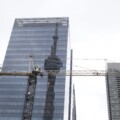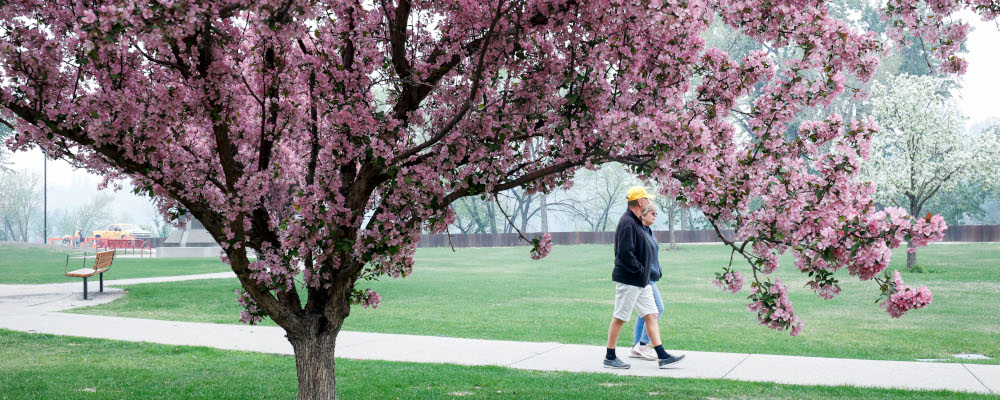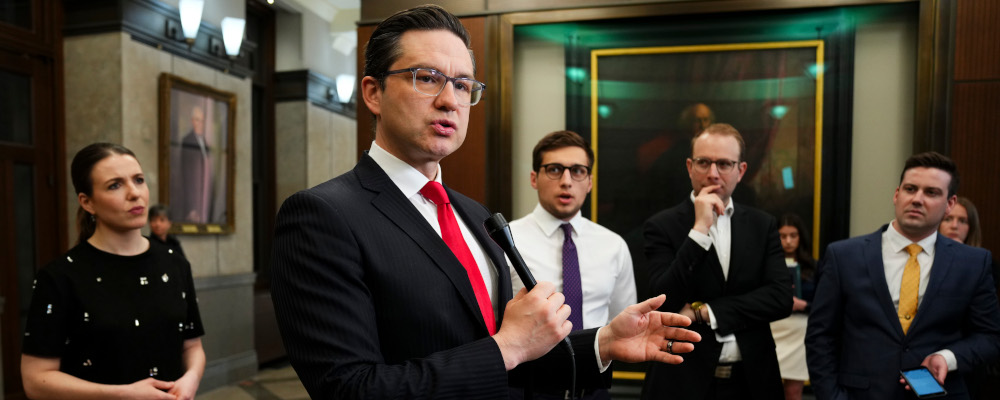Canada is hot right now. Uncomfortably hot. And it’s not even summer yet. Climate change is often framed as some far-off concern. With forest fires once again burning through Alberta and heat waves mugging Toronto and Vancouver in April, we need to realize that extreme heat is already here. We need to learn how to live with it.
The last eight years were the hottest on record. That’s a big problem for Canada’s cities, where more than seventy percent of us live. We not only need to ensure our communities can deal with extreme heat but also with second-order effects such as increased flooding and an increased need to house people fleeing natural disasters.
The good news is we do have some control over localized temperatures. That may sound like science fiction, but urban design choices can help keep our communities from overheating. For instance, concrete and asphalt absorb and radiate heat. Conversely, vegetation absorbs heat. The balance of permeable surfaces (e.g. soil) to impermeable surfaces (e.g. paved driveways) helps determine the local temperature.
It isn’t just what’s on the ground that helps set the temperature, but what’s above. One of the perennial debates in cities is whether we should allow tall buildings that might cast shade on people’s gardens. But shade doesn’t just make it hard for downtown homeowners to grow tomatoes in the backyard. It also keeps people cool. As Anthony Bourdain once said, “Walk on the shady side of the street. The sun is not your friend.”
The shade doesn’t just directly cool you off by creating a barrier between you and the sun. It also prevents the ground from absorbing that sunlight and radiating heat. The differences in temperature between a concrete jungle and a greener community are no joke. The average air temperature in large and medium North American cities is between one and three degrees hotter than outside of the city, with differences as high as 12 degrees. The difference between 15 and 18 degrees is the difference between sweater and t-shirt weather. The difference between 23 and 26 degrees is, for many, the difference between tolerable and intolerable weather.
Adding more green space can help make hot days in the city more tolerable. Not only does it have some of the benefits mentioned above by incorporating more shade and impermeable surfaces, but it also gives apartment dwellers somewhere to stretch their legs on a hot day. If you live in a detached house, you can sit in the backyard and enjoy the shade and breeze. Not so if you live in an apartment. If there isn’t adequate green space around, you might not have a way to get outside and remain cool on a hot day. Some people are prisoners in their own homes on hot days.
Localized heat isn’t the only impact on cities from extreme temperatures. It also comes with worsening flooding, as we’ve seen throughout North America over the last decade. Indeed, while flooding is often thought of as a coastal problem, some of the worst floods have been in the middle of the continent—from Calgary all the way down to Texas. Fortunately, there are ways to adapt.
This brings us back to impermeable surfaces. Not only do they help reduce localized heat, but they help ensure drainage. While water can pool on asphalt, it’s absorbed by soil. If water has nowhere to go, it pools. This doesn’t mean we need to tear up all the streets. But having adequate drainage can be the difference between bad flooding and catastrophic flooding.
Many cities also need to deal with coastal flooding. Indeed, it’s something many are working on.
In the wake of Hurricane Sandy, New York metro area politicians started thinking more seriously about how to mitigate future floods. One example is the city’s iconic Battery Park. It’s a beautiful green space at the southern tip of Lower Manhattan that looks out onto the Statue of Liberty. If you’ve watched TV, you’ve seen it. But it’s about to get a major renovation. Part of the park is going to be demolished and rebuilt ten feet higher. It’s a big, controversial project. But it could help protect the area from rising sea levels and storm surges.

Another example is right here in Toronto. The Port Lands Flood Protection Project is a $1.25 billion project aimed at diverting water from the Don River into Lake Ontario. The price tag might sound hefty, but there are around 80,000 people living in the Waterfront Service Area, and Toronto’s city core anchors a region of seven million people. We can’t afford to let Bay Street flood.
Finally, there’s the matter of housing people affected by natural disasters. Consider the people being evacuated right now in Alberta. They need to live somewhere until they can go home—if they’re lucky enough to have a home to return to. Fortunately, rental vacancy rates are relatively high in Alberta. But the provincial rate decreased from 6.5 percent to 3.7 percent between October of 2021 and October of 2022. If the vacancy rate keeps ticking down, it will get much harder to house people fleeing natural disasters.
It’s almost unthinkable that a big, rich country like Canada would have a problem housing people displaced by forest fires. But if you’ve lived in a city with chronically low vacancy rates like Toronto or Vancouver, it’s not hard to imagine at all.
Planning regimes in Canada’s major centers have prioritized preserving the “character” of existing neighbourhoods over allowing more home construction. As a result, it’s getting hard to house existing residents, let alone newcomers. Re-housing more than twenty thousand people in a pinch isn’t easy. Housing scarcity makes it harder. We should choose housing abundance instead.
Climate change isn’t some far-off concern. We have to live with extreme heat right now—whether we like it or not. There aren’t any easy answers. But the sooner we come to grips with the reality of our climate, the sooner we can find solutions.
Recommended for You

Malcolm Jolley: Cool Chardonnays for warm days

Five Tweets on Western Canada’s devastating wildfires

Kirk LaPointe: The heated politics of B.C.’s growing wildfires

Christopher Hume: Canada’s architects are building boring and bland cities










